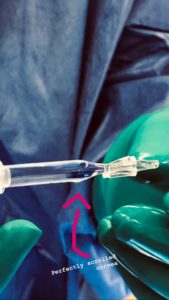Safety is our top priority—recently, the first Descemet Membrane Endothelial Keratoplasty (DMEK) surgery was performed at Elliot Hospital for the safety of a patient.
DMEK is a partial-thickness cornea transplant procedure. “We remove the thin layer of cells that aren’t working in the patient’s cornea and replace those cells with the graft tissue from a healthy cornea that is one cell layer thick,” Dr. Sara Bozorg, an ophthalmologist at the Medical Eye Center, explains. The Medical Eye Center in Manchester is affiliated with Elliot Health System.
Dr. Bozorg performed the DMEK surgery for the first time at Elliot Hospital after safety concerns were raised for the patient. “The patient wasn’t a good candidate for the surgery at The Elliot’s one-day surgery center because he was more fragile, a little bit older, and had to be in the hospital setting because of several other medical problems. So, instead of saying we couldn’t do the surgery, Elliot Hospital said the surgery could be done there.”
The patient had what’s called cornea edema which causes your cornea to swell and no light to get through the cornea. Dr. Bozorg says it can become very painful. “I think this surgery will really change his lifestyle. He was in a lot of pain and couldn’t see anything,” Dr. Bozorg explains.
Dr. Bozorg says all the staff at The Elliot prepared for the surgery several weeks out to make sure all equipment was ready for the surgery. “I think everyone was excited to see the tissue and to make sure everything went smoothly. We had zero hiccups, which is sometimes rare for any procedure.”
The surgery took a little less than an hour. Following the procedure, the patient had to lie flat on his back for an hour and once it was determined it was safe for him to go home, he was discharged.
Dr. Bozorg says a gas bubble was put into the patient’s eye to float the graft to where it needed to be. That means for at least two days following his surgery, the patient had to lie flat on his back and only got up to eat and use the bathroom. The patient has also been monitored closely by the doctor throughout the healing process.
To qualify for DMEK a patient must have a problem with the last cell layer in the cornea. If a patient has a problem with a different layer of the cornea then they aren’t a candidate for the surgery.
Dr. Bozorg also says the percentage of graft rejection for DMEK is extremely rare, less than 1%. For a regular full thickness cornea transplant it is about 17%. “This surgery is unique because most times patients don’t need any sutures or stitches. Patients also see more clearly within a few weeks, compared to a full thickness cornea transplant,” Dr. Bozorg says.

Caption: Healthy cornea tissue transplanted into patient at The Elliot.
